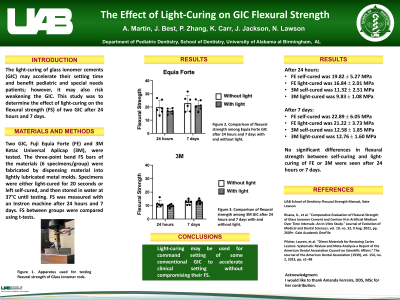Restorative
426 - The Effect of Light-Curing on GIC Flexural Strength

.jpg)
Alexa R. Martin, DMD
Resident
University of Alabama at Birmingham
University of Alabama at Birmingham
Vestavia, Alabama, United States- JB
Jed Best, DDS
University of Alabama at Birmingham
- PZ
Ping Zhang, DDS
University of Alabama at Birmingham
- KC
Kimberly Carr, DMD
University of Alabama at Birmingham
- JJ
Janice Jackson, DMD
University of Alabama at Birmingham
- NL
Nate Lawson, DMD
University of Alabama at Birmingham
- JJ
Janice G. Jackson, DMD
Program Director
University of Alabama at Birmingham School of Dentistry
Birmingham, Alabama, United States
Presenting Author(s)
Co-Author(s)
Program Director(s)
Purpose:
The light-curing of glass ionomer cements (GIC) may accelerate their setting time and benefit pediatric and special needs patients; however, it may also risk weakening the GIC. This study was to determine the effect of light-curing on the flexural strength (FS) of two GIC after 24 hours and 7 days.
Methods:
Two GIC, Fuji Equia Forte (FE) and 3M Ketac Universal Aplicap (3M), were tested. The three-point bend FS bars of the materials (6 specimens/group) were fabricated by dispensing material into lightly lubricated metal molds. Specimens were either light-cured for 20 seconds or left self-cured, and then stored in water at 37°C until testing. FS was measured with an Instron machine after 24 hours and 7 days. FS between groups was compared using t-tests.
Results:
The FS of self-cured and light-cured FE were 19.82 ± 5.27 (mean ± standard deviation) MPa and 16.84 ± 2.01 MPa after 24 hours, and 22.89 ± 6.05 MPa and 21.22 ± 3.73 MPa after 7 days, respectively. The FS of self-cured and light-cured 3M were 11.32 ± 2.51 MPa and 9.83 ± 1.08 MPa after 24 hours, and 12.58 ± 1.85 MPa and 12.76 ± 1.60 MPa after 7 days, respectively. No significant differences in FS between self-curing and light-curing of FE or 3M were seen after 24 hours or 7 days.
Conclusion:
Light-curing may be used for command setting of some conventional GIC to accelerate clinical setting without compromising their FS.
Identify Supporting Agency and Grant Number:

.jpg)